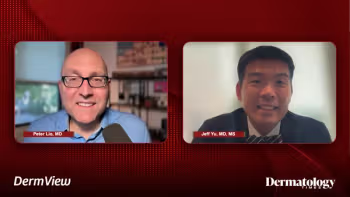
Study Finds High Relapse Rate After Discontinuing PsO Biologics
Researchers suggested that early intervention with less than 2 years of disease duration was associated with a lower risk of relapse.
Although a potential disease-modifying effect has been suggested with the use of IL-23 inhibitors for psoriasis, many patients typically see relapses after drug discontinuation.1-2 With little information currently available on drug-free remission (DFR) after biologics discontinuation, a recent study aimed to investigate the topic and identify potential risk factors predictive for relapse.3
Methods
In total, 48 Taiwanese patients who participated in the immvent (
Results
Researchers followed up with all patients for at least 96 weeks after the end of studies, with the median follow-up time being 919 days. Overall, the study stated that 38 of 42 (90.5%) patients experienced a relapse after discontinuing trial biologics during the follow-up period. In all patients who experienced relapse, researchers reported the median DFR was 104 days. Most patients (32 of 42; 76.2%) had relapses within the first year, leading researchers to further focus on the relapse rate of this time period.
Biologics were reinitiated in 9 of 42 patients within 6 months, 17 of 42 patients within 1 year, and 29 of 41 patients within 2 years. After the discontinuation of biologics, the DFS at weeks 12, 24, 36, and 52 were 69.0%, 42.9%, 35.7%, and 23.8%, respectively.
Figure. Analysis of PsO Relapse After Discontinuation1
Drug
% Relapse in 1 Year
Median DFR
Risankizumab
66.7% (14 of 21)
102 Days
Guselkumab
84.6% (11 of 13)
49 Days
Mirikizumab
87.5% (7 of 8)
79 Days
DFR, drug-free remission
The study found the Kaplan–Meier survival analysis showed differences in survival among the biologics. Risankizumab demonstrated a significantly better 1-year DFS compared to guselkumab and mirikizumab (Figure). Despite limited direct comparisons of IL-23 inhibitors regarding relapse rates after discontinuation, researchers stated risankizumab and guselkumab were found to have better drug survival. Systematic reviews indicated similar efficacy between guselkumab and risankizumab in reducing tissue resident memory T (Trm) cells. Variations in treatment duration (6, 5, or 3 years) might explain the differences in 1-year DFS. Further studies are needed to explore how treatment duration affects disease outcomes.
The study also highlighted the benefits of early intervention, particularly in patients with a disease duration of less than 2 years, showing a lower risk of relapse and faster normalization of Trm cells.4-5 While aggressive treatment within the first 2-3 years may be beneficial, researchers noted that real-world data on patients with short disease duration is limited. Additionally, the study found no significant link between rapid improvement (like achieving psoriasis area and severity index score (PASI) 90) and DFS, but maintaining PASI 90 was associated with better 1-year DFS. The study did not find prior biologic use to be a predictor of relapse-free survival, possibly due to all patients being naïve to IL-23 inhibitors.
Conclusion
Overall, 90.5% of patients experienced relapse after discontinuing trial biologics, with a median DFR duration of 104 days and 76.2% relapsing within the first year. The study found that factors such as the type of biologic used, disease duration (≤2 years), and achieving PASI 90 improvement were associated with better 1-year DFS. Although early treatment and sustained improvement are linked to better DFS, the study stated the impact of longer treatment periods on DFS and Trm cells remains unclear.
The study's limitations included small sample size and less stringent relapse criteria, though the single-center design ensured consistent treatment and efficacy assessment. Researchers suggested larger studies with extended follow-up are needed to confirm these findings.
References
- Bellinato F, Chiricozzi A, Piaserico S, Targher G, Gisondi P. Could targeted pharmacotherapies exert a "disease modification effect" in patients with chronic plaque psoriasis? Int J Mol Sci. 2022 Oct 25;23(21):12849. doi: 10.3390/ijms232112849. PMID: 36361639; PMCID: PMC9658165.
- Blauvelt A, Leonardi CL, Gooderham M, et al. Efficacy and safety of continuous risankizumab therapy vs treatment withdrawal in patients with moderate to severe plaque psoriasis: A phase 3 randomized clinical trial. JAMA Dermatol. 2020 Jun 1;156(6):649-658. doi: 10.1001/jamadermatol.2020.0723. PMID: 32267471; PMCID: PMC7142813.
- Hsieh CY, Hsu FL, Tsai TF. Comparison of drug-free remission after the end of phase III trials of three different anti-IL-23 inhibitors in psoriasis. Dermatol Ther (Heidelb). July 29, 2024. doi:10.1007/s13555-024-01229-6
- Yeh CP, Huang YW, Tsai TF. Comparison of the relative efficacy of different biologics in different body areas in patients with moderate to severe psoriasis receiving biologics and tofacitinib in phase 3 randomized controlled trials: a 15-year single-center experience. Expert Review of Clinical Pharmacology. 2022. 15(7), 887–895.
https://doi.org/10.1080/17512433.2022.2103538 - Ruggiero A, Fabbrocini G, Cinelli E, et al. Real world practice indirect comparison between guselkumab and risankizumab: Results from an Italian retrospective study. Dermatologic Therapy. 2022; 35(1):e15214. doi:10.1111/dth.15214
Newsletter
Like what you’re reading? Subscribe to Dermatology Times for weekly updates on therapies, innovations, and real-world practice tips.


















